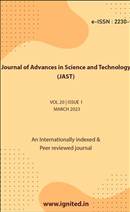The Evolution of Aircraft Engines
DOI:
https://doi.org/10.29070/379t8346Keywords:
evolution, aircraft engines, technological advancements, innovation, engine performance, fuel efficiency, environmental sustainability, materials, design, manufacturing procedures, aircraft safety, dependability, economic considerations, aviation industry, future directions, research, existing body of knowledgeAbstract
This compact systematic study here is conducted here to know the evolution of the engines ofaircraft. This study follows with several points that are included in the next parts. The aviation industry hasbeen shaped by the remarkable journey of technological advancements and innovation that has taken placeduring the evolution of aircraft engines. It investigates how advancements in engine performance, fuelefficiency, and environmental sustainability are influenced by changes in materials, design, andmanufacturing procedures. The impact of engine evolution on aircraft safety, dependability, andeconomic considerations for the aviation industry are also discussed in the analysis. The findingshighlight potential future directions for continued innovation and contribute to a deeper comprehensionof the factors that have influenced the evolution of aircraft engines. This study sheds light on thetechnological advancements that have propelled aircraft engine research forward and added to theexisting body of knowledge.Downloads
References
Arabul, A.Y., Kurt, E., Keskin Arabul, F., Senol, İ., Schrötter, M., Bréda, R. and Megyesi, D., 2021. Perspectives and development of electrical systems in more electric aircraft. International Journal of Aerospace Engineering, 2021, pp.1-14.
Arias Chao, M., Kulkarni, C., Goebel, K. and Fink, O., 2021. Aircraft engine run-to-failure dataset under real flight conditions for prognostics and diagnostics. Data, 6(1), p.5.
Chau, T., Kenway, G. and Kiris, C.C., 2022. Conceptual Exploration of Aircraft Configurations for the SUSAN Electrofan. In AIAA SciTech 2022 Forum (p. 2181).
Corbin, J.C., Schripp, T., Anderson, B.E., Smallwood, G.J., LeClercq, P., Crosbie, E.C., Achterberg, S., Whitefield, P.D., Miake-Lye, R.C., Yu, Z. and Freedman, A., 2022. Aircraft-engine particulate matter emissions from conventional and sustainable aviation fuel combustion: comparison of measurement techniques for mass, number, and size. Atmospheric Measurement Techniques, 15(10), pp.3223-3242.
Cusati, V., Corcione, S., Ciliberti, D. and Nicolosi, F., 2022. Design Evolution and Wind Tunnel Tests of a Three-Lifting Surface Regional Transport Aircraft. Aerospace, 9(3), p.133.
Forest, F., Cochard, Q., Noyer, C., Joncour, M., Lacaille, J., Lebbah, M. and Azzag, H., 2020, November. Large-scale vibration monitoring of aircraft engines from operational data using self-organized Models. In annual conference of the PHM society (Vol. 12, No. 1, pp. 11-11).
Gazaix, A., Gallard, F., Ambert, V., Guénot, D., Hamadi, M., Grihon, S., Sarouille, P., Druot, T.Y., Brézillon, J., Gachelin, V. and Plakoo, J., 2019. Industrial application of an advanced bi-level MDO formulation to aircraft engine pylon optimization. In AIAA Aviation 2019 Forum (p. 3109).
Jansen, R., Kiris, C.C., Chau, T., Machado, L.M., Duensing, J.C., Mirhashemi, A., Chapman, J., French, B.D., Miller, L., Litt, J.S. and Denham, C.L., 2022. Subsonic single aft engine (SUSAN) transport aircraft concept and trade space exploration. In AIAA Scitech 2022 Forum (p. 2179).
Matthes, S., Lee, D.S., De Leon, R.R., Lim, L., Owen, B., Skowron, A., Thor, R.N. and Terrenoire, E., 2022. The Effects of Supersonic Aviation on Ozone and Climate. Aerospace, 9(1), p.41.
Martinet, B., Cappella, A., Philippon, S. and Montebello, C., 2020. Effect of temperature on wear mechanisms of an aluminium-based abradable coating for aircraft engines after a dynamic interaction with a Ti6Al4V blade. Wear, 446, p.203202.
Mukhopadhaya, J. and Rutherford, D., 2022. Performance analysis of evolutionary hydrogen-powered aircraft. ICCT white paper.
Nyssen, F. and Batailly, A., 2019. Thermo-mechanical modeling of abradable coating wear in aircraft engines. Journal of Engineering for Gas Turbines and Power, 141(2).






